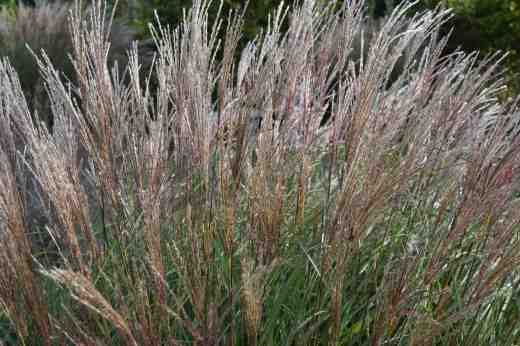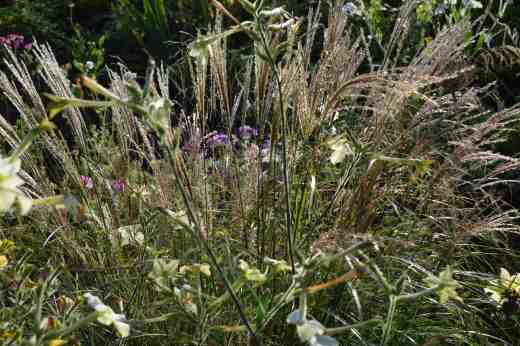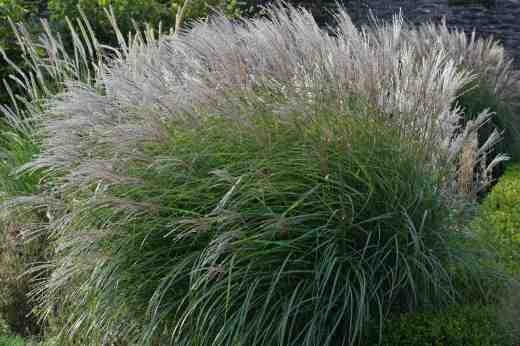Miscanthus ‘Kleine Silberspinne’
Autumn is when many ornamental grasses are at their peak. I think gardeners either get obsessed by them or avoid them like the plague – after all, if you love dahlias and petunias you may find grasses a bit lacking in colour. That is not to criticise anyone that loves dahlias, after all, I do. And I have to have a professional interest in grasses but they have not quite captured my heart as other plants have. I concede that they are pretty and useful but a problem is that people talk of ‘grasses’ as though they are all the same and can be treated in the same way, and nothing could be further from the truth. So I make no apology for liking some grasses and steering clear of others. Lots of ‘grasses’ are not really grasses at all, but that is just getting pedantic.
Without any quibbling at all I confess that miscanthus are possibly my favourite grasses. My already extant interest was piqued when I saw Adrian Bloom’s miscanthus at Foggy Bottom in Norfolk. There are many species of miscanthus but most cultivars are based on Miscanthus sinensis which is native to China, Japan and Korea. The cultivars vary from just 1m high to giants that create greats fountains of foliage 3m high. This is all the more amazing when you consider that these are herbaceous grasses, dying down in winter and bursting into growth in spring and achieving their ultimate height in just eight months. As well as elegant foliage, they produce feathery and then fluffy flower heads at the stem tips in late summer. Some only just manage to bloom before the autumn frosts and it has been an aim for breeders to create cultivars that bloom early. This may be a problem in the future, limiting their use in areas of the world where seeding alien grasses could be an issue. But in the UK and Ireland, they rarely set seed and, unlike some other grasses, do not become a nuisance.
I have not grown enough miscanthus but one that gets my vote is ‘Kleine Silberspinne’. This has been given an AGM and was bred by Ernst Pagels, (1913-2007) who created many grasses and other plants in his nursery on the German/Netherlands border. It is a moderate sized miscanthus with flowering stems reaching 1.8m at a push, often a little smaller. It is hard to believe in spring, after its annual skinhead trim, that the yard-brush you have just created will become a fountain of arching foliage. It is important to do the trim before much new growth has been produced or you will have the chore of cutting out the dead stems while leaving the young, green shoots. Life is far too short for this.
‘Kleine Silberspinne’ pushes up its flowering stems in late August and the plumes are reddish at first but they change to silver as they develop (after all, the name means ‘little silver spider’). As you would expect, and want, the plants move with the merest breeze. I love the way this plant changes throughout the season, pays its way each month and just gets better throughout summer until it reaches a crescendo in October.
I have some exciting plans for this plant which is now established enough to be divided into lots more plants in spring (the best time to do it). I plan to intersperse them with pale pink hardy fuchsias (‘Whitenights Blush’) or/and Rosa glauca – the hips will look great with the plumes.
Geoff’s rating
9/10
Garden rating
9/10



We like grasses for contrast
I love grasses! I love the texture and movement they bring to a planting scheme and I enjoy thinking of new ways to grow them. One way I’m trying is growing them with roses, too. I grow two Miscanthus – “Ferner Osten” which has wonderful, velvety wine coloured plumes at this time of year (nice alongside the plum foliage of Cotinus leaves) and “Morning Light”, which doesn’t usually produce flower plumes, but forms a beautiful fountain of silvery leaves.
It is so easy to mix grasses with other foliage – and the now ‘traditional’ prairie border – but more of a challenge to mix them with other plants. Your rose idea sounds intriguing and fun.
I’ll keep you posted on my attempts!
Thank you – look forward to that.
In fact, I feel a post coming on!! 😉